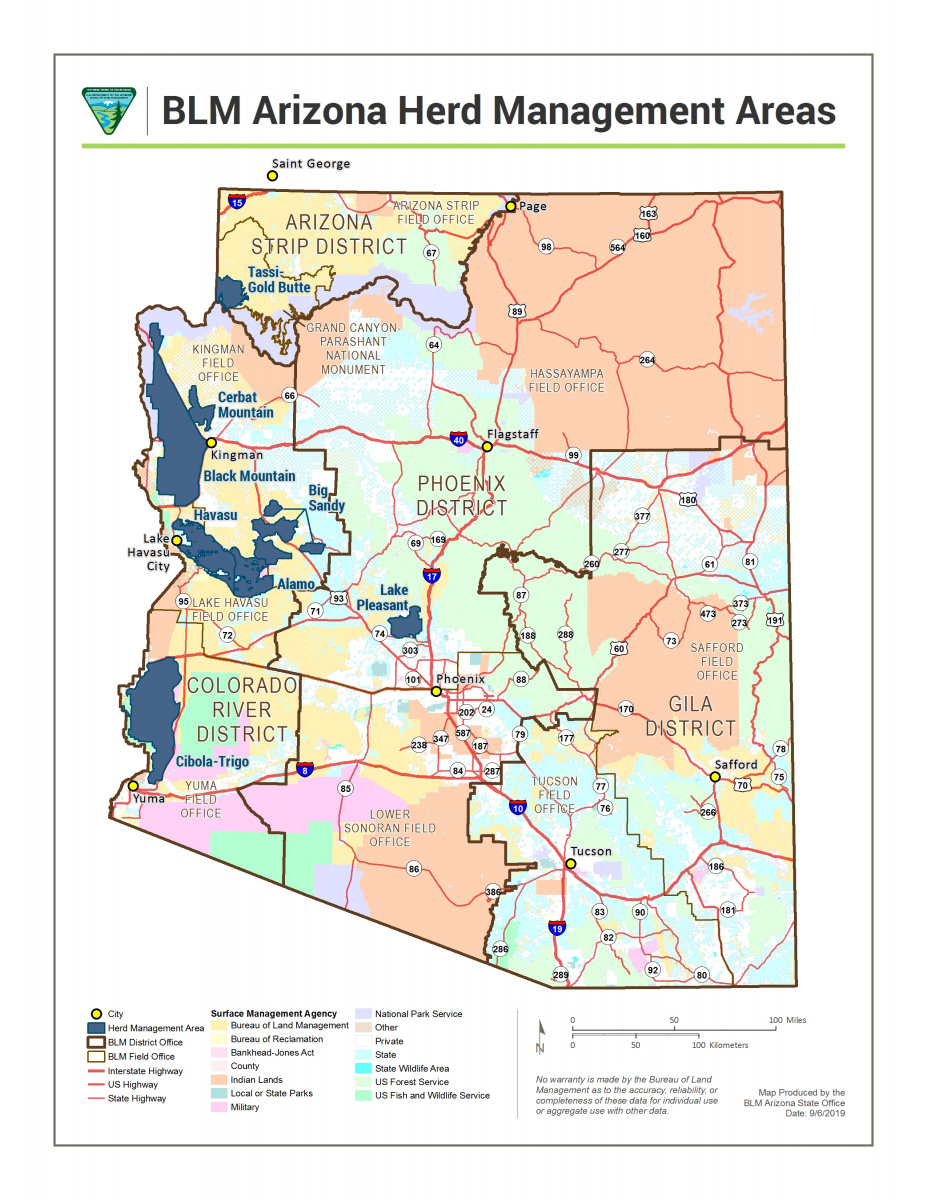Cibola-Trigo HMA
In the Cibola-Trigo Herd Management Area, approximately 90 percent of the wild burros are gray with the remaining 10 percent being black, brown, white, pinto, or piebald. Some posses the shoulder cross characteristics of the ancestral Nubian and Somali wild asses and many have the leg barring associated with the Nubian wild ass. The mean shoulder height of adult burros in 48 inches (12 hands) and the mean weight is approximately 350 pounds.
There are approximately 120 wild horses in the Cibola-Trigo HMA. There are two small herds scattered throughout the area, the Gould Wash Herd and the Castle Dome Wash Herd. The Gould Wash Herd has between 60-75 animals (areal reconnaissance). This heard predominately roams on BLM administered lands with some use on the Yuma Proving Grounds (YPG). Their primary food source comes from the desert washes and mountainous areas. There horses are large; standing between 15-16 hands high (60-64 inches) and weighing between 800 to 1,000 pounds. Colors include are mostly bay and black but dun, pinto, and appaloosa also occurs in this herd. The Castle Dome Wash Herd has between 50-60 animals. This herd predominately roams on YPG with a little use on BLM and Imperial National Wildlife Refuge lands. Their primary food source comes from the desert washes and sand dunes. These horses come in a variety of sizes and colors. Some have mustang characteristics, but most have breeding that show appaloosa and quarter horse characteristics.
Location: The Cibola-Trigo (C-T) HMA is located in the Southwest corner of Arizona and Southeast Corner of California. Important communities near the C-T HMA are Yuma and Quartzsite in Arizona and Blythe and Palo Verde in California. Major physical features are: the Colorado River, Cibola Lake, Cibola Valley, Trigo Mountains, Chocolate Mountains and the Laguna Mountains. The C-T HMA encompasses approximately 179,000 acres.
Size: HMA:179,000; HA: 263,700
Topography/Vegetation: This region of the lower Sonoran Desert is characterized by broad valleys and desert plains having gentle slopes and sparse vegetation, with rocky, sharply eroded desert mountain ranges abruptly ridging the gentle terrain. Drainage is primarily westerly toward the Colorado River which flows from north to south through the entire length of the west side of the C-T HMA. Elevations range from a high of 3,314 feet on the Cunningham Mountain, to a low of approximately 100 feet at Yuma.
Vegetation consists of mostly perennial forage and some ephemeral forage. Perennial forage within the C-T HMA typically makes most of its growth and reproduces during the cool season by taking advantage of the gentle storms that move in from the Pacific coast. Precipitation that occurs during the hot summer months is generally unavailable to the perennial plants except in the sandy washes dues to the high rate of evaporation. Ephemeral forbs are of two types: summer and winter ephemerals. Summer ephemerals are scarce and less common in the C-T HMA. Winter ephemerals are by far the most abundant and widespread, especially Indian wheat (Plantago insularis). The difference between summer and winter ephemeral forbs response to precipitation is optimum germination temperatures.
Wildlife: The C-T HMA provides habitat for more than 40 species of mammals, 250 species of birds, 30 species of reptiles and 3 species of amphibians. The major grazing wildlife are: bighorn sheep (Ovis canadensis nelsoni) and desert mule deer (Odocoileus hemionus).
AML: The Appropriate Management Level (AML) for the C-T HMA is 165 burros and 150 horses.

